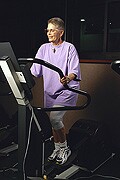

Exercise appears to help control an irregular heartbeat known as atrial fibrillation in obese people, a new study finds.
Australian researchers found that “cardiorespiratory fitness” reduced the risk that this potentially dangerous heartbeat will return by as much as 84 percent — even more than losing weight. Cardiorespiratory fitness refers to the ability of the heart and lungs to supply oxygen to the body during sustained physical activity.
“This study adds to a growing body of evidence that aggressive risk factor management with increased physical activity should be an integral component of management of atrial fibrillation,” said lead researcher Dr. Prashanthan Sanders, director of the Center for Heart Rhythm Disorders at the University of Adelaide in Australia.
Atrial fibrillation, the most common abnormal heart rhythm, affects about 2.7 million Americans, according to the American Heart Association. Obesity and inactivity are risk factors for atrial fibrillation, which can lead to stroke, the researchers pointed out.
One expert cautioned that additional research is needed to confirm the findings. Also, patients should consult with their doctor before embarking on an exercise program.
The report was published online Aug. 24 in the Journal of the American College of Cardiology.
For the study, Sanders and colleagues assigned 308 patients with atrial fibrillation to one of three groups based on their level of fitness: low, adequate, or high fitness. All had a body mass index (BMI) of 27 or more, meaning they were overweight or obese.
The groups were followed for about four years to see how their level of fitness affected the recurrence of the abnormal heartbeat. Patients were also offered a doctor-led weight loss and exercise program.
After four years of follow-up, 84 percent in the high fitness group no longer had atrial fibrillation, compared with 76 percent in the adequate group and 17 percent in the low fitness group, the researchers found.
Sanders’ team also found that for every increase in “metabolic equivalent” — a measure of the amount of oxygen used at rest — the risk of atrial fibrillation recurrence was reduced 20 percent.
Those with increases of two or more metabolic equivalents who also lost weight had especially dramatic declines in the likelihood of atrial fibrillation recurrence, the findings showed.
“Increased physical activity to gain cardiorespiratory fitness is associated with a reduction in atrial fibrillation burden and maintenance of a normal heart rhythm,” Sanders said.
Dr. Paul Thompson, chief of cardiology at Hartford Hospital in Connecticut, said that exercise is a good way to reduce the chances of developing atrial fibrillation in the first place.
“Folks can probably reduce the chance of getting atrial fibrillation by being moderately physically active,” he said.
“In addition, if they get atrial fibrillation and get treated for it, they can reduce their recurrence rate and need for other medications and treatments by starting an exercise training program and getting into better physical shape. Losing weight also helps, separately from the exercise,” Thompson said.
“A great regimen is at least 30 minutes of brisk walking daily,” he said.
But Thompson, author of an accompanying journal editorial, added that becoming fit should not be equated with habitual physical activity.
“Among individuals who have done tons of exercise for their whole lives, like lifelong endurance athletes,” he said, increasing levels of physical activity might possibly raise the risk of atrial fibrillation.
“The problem for most folks, however, is not too much exercise but getting even a little bit of exercise,” he said.
Dr. Gregg Fonarow, a professor of cardiology at the University of California, Los Angeles, voiced some caution after reviewing the findings.
“Traditional treatment for patients with atrial fibrillation has not focused on weight loss or exercise training,” he said.
“Programs to promote weight loss and improve cardiorespiratory fitness may help patients with atrial fibrillation decrease the risk of recurrent atrial fibrillation,” Fonarow said. “However, additional studies are needed to replicate these findings as well as to determine if there are any benefits in terms of stroke risk reduction or improved survival.”
More information
For more about atrial fibrillation, visit the American Heart Association.
Source: HealthDay
Copyright © 2025 HealthDay. All rights reserved.

Leave a Reply